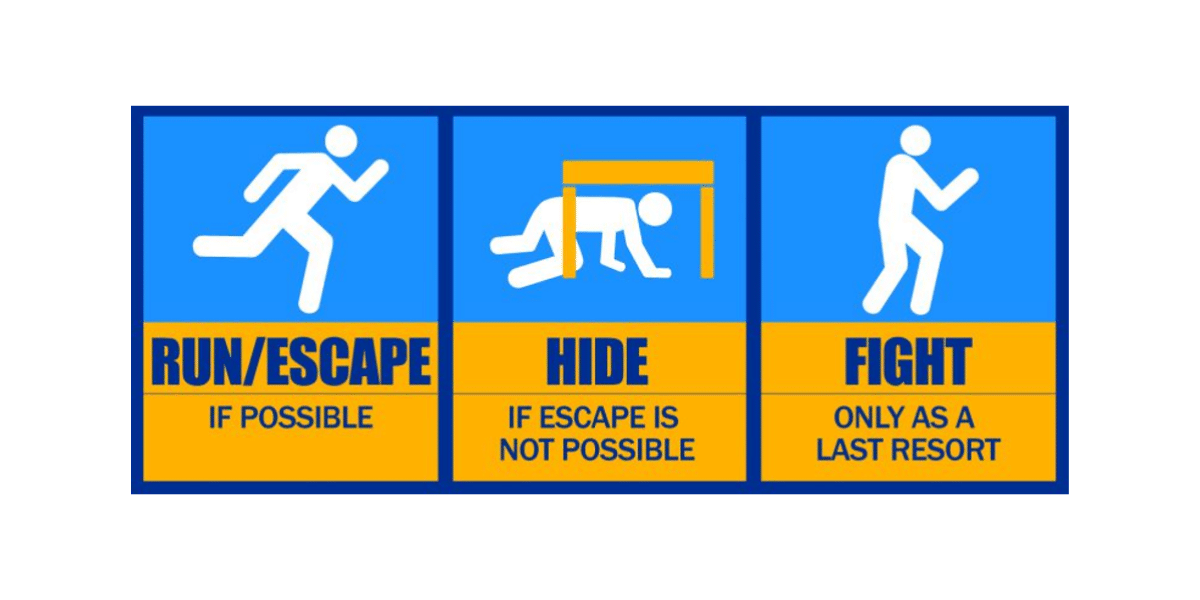What we can all do to mitigate the threat of an active assailant
By Jamie Ridenhour
We hear news reports about active assailant incidents all too often lately. Sadly, the incidents seem to be on the rise again after subsiding during 2020. Prior to that, 2019 was a very bad year with an average of one incident every week. The statistics are frightening and it can feel like the nature of these occurrences means there is little we can do to stop them. There are, however, some very real efforts that we can all take to mitigate the risk of, or loss of life from, an active assailant incident.
Mitigation measures can occur before, during, and after an incident occurs. Understanding indicators that active assailants often display can potentially mitigate an incident before it happens. Knowing some options can help keep you safe during an incident. Finally, understanding how to react post-incident can assist first responders in doing their job effectively.
Before an incident
Intervention
Intervention plays a key role in stopping these tragedies before they occur. Greater public awareness of some of the traits that many attackers share can make a significant difference in our ability to mitigate these attacks. That awareness and a willingness to alert authorities has had a positive impact on stopping attacks before they happen.
Grievances
Active assailant perpetrators often feel that they have been personally wronged. This can come from perceived slights in the personal, sociological, romantic, work, or other realms. Often times there can also be a malice against groups because of their gender, sexual orientation, ethnicity, race, socioeconomic, or religious affiliations or identity.
Unfortunately, the Internet and social media have served to amplify these perceptions. Confirmation for virtually any viewpoint can be found online today and it has been shown that many assailants become steeped in the rhetoric and ideology of fringe groups that are easy to access online.
Stressors
Stressors are another factor that a large percentage of active assailants have in common. We all face some type of stress in our daily lives, but for some, stressors are more significant. An FBI report found that active shooters typically experienced an average of 3.6 separate stressors in the year before they attacked. It is important to learn to recognize some of the stressors that have been noted in assailants:
- Mental health
- Financial strain
- Workplace conflict
- Conflicts with friends, peers or parents
- Marital conflicts
- Drug and alcohol abuse
- Physical injury
- Sexual stress or frustration
Concerning Behaviors
77% or more of active assailants spend a week or more planning their attack according to the FBI report. During that time, they will often exhibit some common concerning behaviors. The people most likely to notice these behaviors are those who know the potential assailant best, including family and friends. Even when it is recognized, however, it often goes unreported, and those same people may end up being the victims. Some of the behaviors attackers have in common include:
- Mental health
- Interpersonal conflicts
- Leakage (discussing the idea of a violent act)
- Decline in quality of thinking
- Suicidal ideation
- Poor work or school performance
- Threats, confrontations, and aggression
- Idolizing criminals
- New or escalating fascination with violence and/or weapons
- New or intense involvement in fringe idea groups or movements
- Open dialog about hate or violence against groups or demographics
One of the most important behaviors to be aware of is that of leakage. This term refers to the potential assailant’s tendency to discuss the idea of a violent act or ideation of violence, something that would typically be avoided in normal conversations. The fact the idea is present enough in the person’s mind for it to come up in conversation is an important signal that should not be missed. If a person is talking about these things, there is ideation, and ideation can become action.
Social media and online access to fringe groups again plays a part when it comes to ideation. Radical online groups make reinforcement of ideas and hostile discourse easier than ever to come by. The words of anonymous members of fringe groups can often be the drivers behind violent action. Particular note should be made when the leakage involves the mention of these types of groups.
The FBI notes that, “there is no single warning sign, checklist, or algorithm,” to identify a potential attacker. Instead, it is a combination of behaviors that are outside the norm, both for the individual and for society in general that can serve as concerning signals that should possibly be reported. As we have heard on many occasions, “if you see something, say something.”
During an incident
Training materials created by DSI Security Services include a useful set of phrases that help you remember your options if an active assailant situation occurs. Figure Out, Run Out, Hide Out, Call Out, Keep Out, Spread Out and Take Out are 7 easily remembered actions that could keep you from becoming a victim. All seven fit into DSI’s run-hide-fight approach to dealing with an active shooter.
Figure Out
Consistent awareness is perhaps the best tool in the arsenal to help survive an active shooter situation. By being aware of our surroundings and environment, we not only are able to spot a potential danger a earlier, but will be better able to make a quick decision on a course of action when the danger occurs. Don’t allow your brain to make the comfortable response of, “this can’t be happening.” We are hardwired to make sense of situations by fitting them into our normal set of experiences, and this can be a waste of valuable time in an emergency situation.
Be prepared to quickly determine what action gives you the best chance to survive. In many active assailant incidents, the casualties occur within the first 90 seconds. Being mindful of surroundings and prepared to make a decision may give you the chance to escape the danger. In addition, if you are the first to move, people will follow you as an example.
Run Out
This is probably the easiest to remember. When confronted with an active shooter, often the best alternative is to simply run. Freezing in place is one of the biggest mistakes people make in this type of situation and it unfortunately makes a person an easy target. Leave your belongings behind and run to a safer location. If possible, look for routes that provide some concealment from view or protective cover. In an emergency situation there are no restrictions; run through an emergency or employees only door and even break windows or glass doors if you have to.
Hide Out
If you can’t escape completely, find a place to shelter. Look for places that provide concealment from view as well as protective cover. Try to keep your movement options open so that you can escape if an opportunity presents itself.
Call Out
When you have some degree of safety, call 911 as soon as possible. Never assume that someone else has called or that you don’t have any information that hasn’t already been given. The location and number of shooters and descriptions of the shooter and the weapon type can be very important to the police response. Also report any injured persons that you are aware of. If possible, keep the line open to provide more information.
Keep Out
If hiding out is your only option, try to pick a place that can be secured with a lock or by barricading the door. Turn off the lights and stay quiet. Remember that an assailant will typically fire on immediately visible victims. Simply making yourself difficult to get to may save your life.
Spread Out
Especially if you cannot get to a secure room, urge people to spread out. Spreading out will cause the shooter to hesitate when looking for victims and may provide greater opportunities for escape.
Take Out
While we don’t want to encourage unnecessary risk, a simple weapon such as a stick, chair or heavy object may be enough to deter or even stop a perpetrator. The only power they have is in their gun and the only place they can shoot is where it’s pointed. Knocking that gun aside or forcing it to point upwards may be all that’s needed to diffuse the lethality of the immediate situation. Even screaming, kicking, and grabbing are better than standing still.
After an incident
Police will be the initial first responders on the scene. While they are concerned about victims, their priority is to terminate the threat and make sure the area is safe. Do not hinder the police or get in their way by panicking. It’s best to stay in place and keep your hands empty and visible to officers. Obey any commands that they give. Remember, even though they are trained personnel, they are still under a lot of stress in an active assailant situation.
Medical personnel will be next on the scene. Try to give them as much information as you can about victims that need help. Assist them in any other efforts, such as accounting for employees or providing direction to where other people may be. Help and comfort other victims as you are able.
Be prepared and aware
The chances of being faced with an active assailant situation are thankfully slim, but still too high. Being prepared and aware can significantly mitigate loss in these circumstances. Take time to review the information above and pass it along to family and coworkers. Consider how to apply it to workplaces or other situations you are in regularly. It may just be the bit of information that saves a life.







